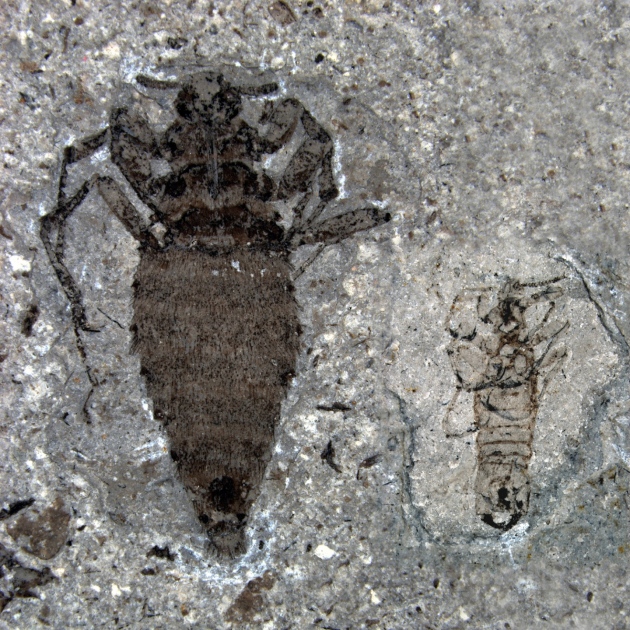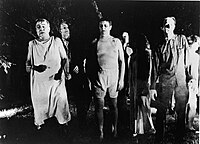Never the less a slew of findings has revealed dinosaurs to be no less ridden by helminth worms, flukes, trematodes, lice and other buggies than modern animals. Just as in modern ecosystems (Planet Parasite) Mesozoic parasites undoubtedly played a profound role in the mortal struggles of dinosaurs affecting distribution, behavior, population density, movements, mate choice, food choice, pathogens, horizontal gene transfer, water usage- the list goes on. Far from being minor players in earth's ecosystems- parasites are indeed the grand puppet masters of life's stage and we are finally appreciating the unheralded ecological role parasites play. It has been a great disservice that biology has traditionally downplayed the role of parasitism ecologically, as parasitism as a life strategy is the dominant mode of life on this planet. And it is not too much of a stretch to imagine parasites were no less dominant ecologically in the Mesozoic.
 |
| Caribou moving in tight formation and fleeing mosquito swarms- the hazy grey areas |
Recent finds in China significantly add to our picture of Mesozoic parasites that may have plagued the dinosaurs.
 |
| Huang et al. Nature |
In the book What Bugged the Dinosaurs George and Roberta Poinar entertain the notion that newly evolving pathogens, spread by biting insects, were at least one of several culprits for the demise of the dinosaurs. The theory and book have been roundly criticized by dinosaur paleontologists for several reasons which we will not go into detail here but you can follow the link at the bottom. Despite, the books' problems, and there are several- the book has merit if only for the amber fossils depicted and the interesting work they document discovering evidence of ancient pathogens in insects. I get the sense that, perhaps for marketing reasons, the dinosaur extinction angle was pursued to sell books. If the book was simply approached as a summary of dino-parasites or Mesozoic insects it would have been a lot more successful.
From my perspective it is a lot more interesting however to imagine not how biting insects killed dinosaurs occasionally- this doubtless happened- but how they may have modified dinosaur movements across the landscape.
An interesting modern example of the small controlling the mighty is documented in this study here. Elephants were thwarted by ants from browsing a certain type of acacia that maintains a symbiotic relationship with the ants. If the elephants browse this tree the ants swarm and the elephant quickly learns after it has its sensitive trunk bit and stung not to browse on it. In return the ants are provided food and shelter in the tree. Now granted its not the perfect model for possible parasite/plant/dinosaur interactions- for one the ant is obviously not a parasite and secondly social insects such as ants were not ubiquitous throughout the whole of the Mesozoic- I believe it is useful for several reasons.
For starters the distinction between parasitism and free living, foraging critters is not as solid as some may presume. For instance mosquitoes are primarily pollinators in addition to slurping up blood. Fleas act as detritivores before taking up residence on Snoopy. In fact it is well known that many "parasitic species" have both free-living and parasitic stages in their life cycle. Notoriously flukes, parasitic spider wasps and "xenomorph aliens" (haha) display various free living and parasitic stages. It is also observable that diets of the organism may change drastically between life stages and/or parasites may enjoy several types of meals congruously. It is easy to imagine the drill-bit like mouth parts of the "pseudofleas"may have
proved useful in tapping into vegetative or resources like sap or phloem.
From this it is not hard to imagine a stand of Jurassic ginkgoes that harbored a high population of giant Jurassic "pseudofleas". The buggies enjoyed occasional offering of sugary sap the tree would exude and they found numerous cryptic hiding spots both in and on the tree. But what the bugs really relished was the protein rich blood of dinosaurs, especially when it was time to lay eggs. And when the bugs sensed the approach of a herd of Mamechisaurs that came to feed on the ginkgoes they gathered en masse literally falling over each-other to get at branch, twig, or leaf tip in order to hop aboard the archosaur. And when the sauropod sensed the swarming, biting, drilling parasites it would move on from this particular stand of trees. Even to dinosaurian minds parasites must have surely been an annoyance.
Now the above scenario and the ideas behind it might seem a bit ad hocish and no doubt highly speculative, but I suggest that these type of intricate relationships are very plausible and, arguably, expected when compared to the myriad intricate ecological relationships involving parasites observed today. And the data suggests parasites matter ecologically.
One of the more noteworthy developments in parasitology is the phenomena of "zombie creatures" a parasite induced behavioral change. The parasite co opts an existing behavior that makes the animal more vulnerable to a predator- the parasites final host in most cases. The mind boggles at the
possibilities for "zombie dinosaurs". Maybe a fluke ridden giant sauropod, rendered nearly blind and confused- perhaps tricked into some rote, stereotyped movement that draws interest to it from theropods- the worms final host.
And in addition to the profound effects parasites induced upon dinosaurian plant predators perhaps even being the ultimate cause of mortality for the largest land herbivores of all time, they no doubt influenced the fate of dinosaurian predators, including that most famous of all, T-rex.
A recent paper available here from PLOS ONE documents a common Avian protozoan infection, trichomonosis aka bird canker, in Tyrannosaurus rex. Allegedly scars from facial bites, the distinctive holes commonly found in the mandibles of tyrannosaurids, are actually the final stages of the parasitic infection and generally render the
animal dead through starvation. Tyrannosaurus, the most dominant terrestrial biter of all time, unable to actually take a bite. Let us imagine what an epidemic of trichomonosis may have been like in the Late Cretaceous.
The peninsula has been overrun by tyrant lizards. And they all were showing some symptoms of trichomonosis parastie infection. A bizarre congruence of events had created this seeming ecological anomaly. Several seasons ago several dozen full grown Alamosaurs wandered down through the one entrance into the peninsula about the size of Rhode Island and became trapped. Over several years these massive dinosaurs died of disease, starvation, and natural causes. The mountains of flesh attracted scavenging Tyrannosaurs and azdharchid pterosaurs. The rexes bred quickly in these good times and after the sauropods were finished off they and the pterosaurs decimated the only two small resident breeding colonies of ceratopsids and hadrosaurs on the peninsula. Now only intrepid ornithomimasaurs and the occasional rogue bull ceratopsid are the only dinosaurs seen besides the hordes of cannibalistic rexes. Some of the largest rexes
Parasites, the ultimate top down control for even the most dominant predators.
Pertinencia
Common Avian Infection Plagued the Tyrant Dinosaurs
Scientific America. What Bugged the Dinosaurs?
Ants Work With Acacia Trees to Prevent Elephant Damage
Tapeworms, Trematodes and other Dinosaur Pests
Zombie Creatures
Support me on Patreon.
Like antediluvian salad on facebook.
Watch me on Deviantart @NashD1.Subscribe to my youtube channel Duane Nash.
My other blog southlandbeaver.blogspot.




No comments:
Post a Comment